CQC Health and Social Care: Communication and ICT Report Analysis
VerifiedAdded on 2022/12/15
|9
|3058
|431
Report
AI Summary
This report delves into the crucial role of communication within the health and social care sector, specifically focusing on the Care Quality Commission (CQC) in the UK. It examines the significance of communication in providing effective services, differentiating between formal and informal communication methods, and analyzing their respective strengths and weaknesses. The report explores various communication formats, including oral and written communication, and provides practical guidance on producing effective presentations. Furthermore, it investigates the impact of Information and Communication Technology (ICT) on communication, highlighting both the advantages and potential hazards of technology in service delivery. The report concludes by emphasizing the importance of overcoming communication barriers and leveraging technology to enhance service user experiences and improve overall efficiency within the health and social care landscape.

Health and Social
Care
Care
Paraphrase This Document
Need a fresh take? Get an instant paraphrase of this document with our AI Paraphraser
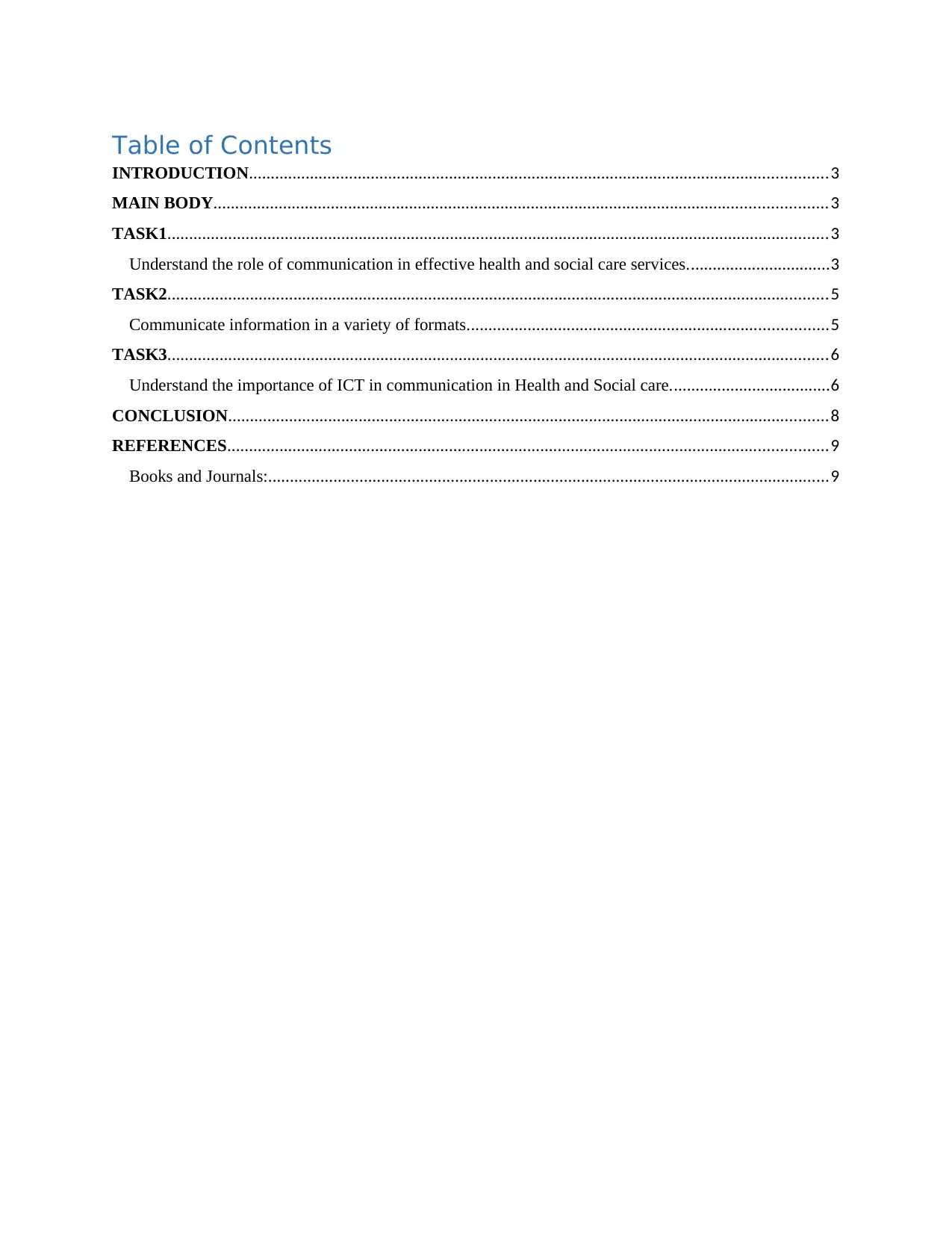
Table of Contents
INTRODUCTION.....................................................................................................................................3
MAIN BODY.............................................................................................................................................3
TASK1........................................................................................................................................................3
Understand the role of communication in effective health and social care services.................................3
TASK2........................................................................................................................................................5
Communicate information in a variety of formats...................................................................................5
TASK3........................................................................................................................................................6
Understand the importance of ICT in communication in Health and Social care.....................................6
CONCLUSION..........................................................................................................................................8
REFERENCES..........................................................................................................................................9
Books and Journals:.................................................................................................................................9
INTRODUCTION.....................................................................................................................................3
MAIN BODY.............................................................................................................................................3
TASK1........................................................................................................................................................3
Understand the role of communication in effective health and social care services.................................3
TASK2........................................................................................................................................................5
Communicate information in a variety of formats...................................................................................5
TASK3........................................................................................................................................................6
Understand the importance of ICT in communication in Health and Social care.....................................6
CONCLUSION..........................................................................................................................................8
REFERENCES..........................................................................................................................................9
Books and Journals:.................................................................................................................................9
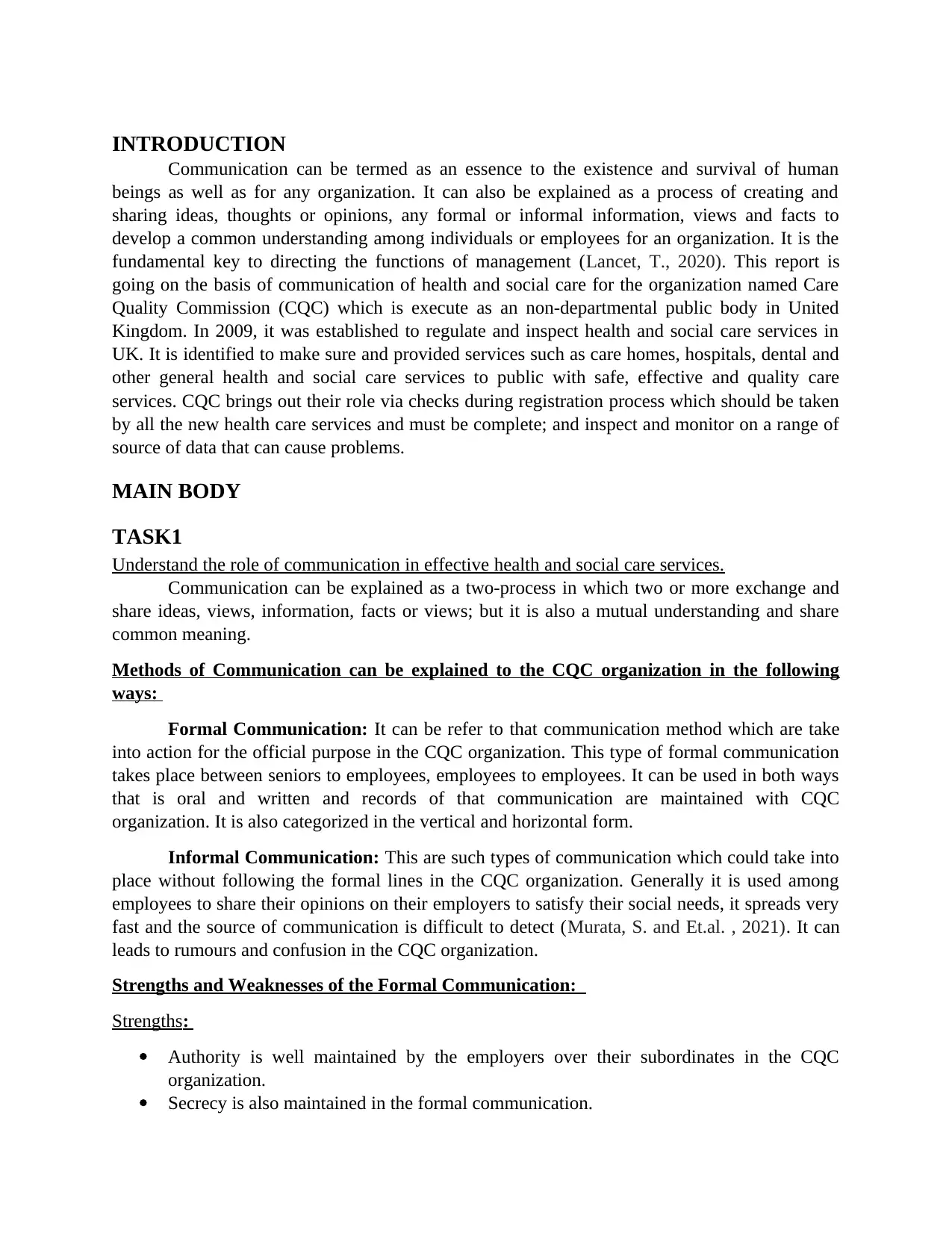
INTRODUCTION
Communication can be termed as an essence to the existence and survival of human
beings as well as for any organization. It can also be explained as a process of creating and
sharing ideas, thoughts or opinions, any formal or informal information, views and facts to
develop a common understanding among individuals or employees for an organization. It is the
fundamental key to directing the functions of management (Lancet, T., 2020). This report is
going on the basis of communication of health and social care for the organization named Care
Quality Commission (CQC) which is execute as an non-departmental public body in United
Kingdom. In 2009, it was established to regulate and inspect health and social care services in
UK. It is identified to make sure and provided services such as care homes, hospitals, dental and
other general health and social care services to public with safe, effective and quality care
services. CQC brings out their role via checks during registration process which should be taken
by all the new health care services and must be complete; and inspect and monitor on a range of
source of data that can cause problems.
MAIN BODY
TASK1
Understand the role of communication in effective health and social care services.
Communication can be explained as a two-process in which two or more exchange and
share ideas, views, information, facts or views; but it is also a mutual understanding and share
common meaning.
Methods of Communication can be explained to the CQC organization in the following
ways:
Formal Communication: It can be refer to that communication method which are take
into action for the official purpose in the CQC organization. This type of formal communication
takes place between seniors to employees, employees to employees. It can be used in both ways
that is oral and written and records of that communication are maintained with CQC
organization. It is also categorized in the vertical and horizontal form.
Informal Communication: This are such types of communication which could take into
place without following the formal lines in the CQC organization. Generally it is used among
employees to share their opinions on their employers to satisfy their social needs, it spreads very
fast and the source of communication is difficult to detect (Murata, S. and Et.al. , 2021). It can
leads to rumours and confusion in the CQC organization.
Strengths and Weaknesses of the Formal Communication:
Strengths:
Authority is well maintained by the employers over their subordinates in the CQC
organization.
Secrecy is also maintained in the formal communication.
Communication can be termed as an essence to the existence and survival of human
beings as well as for any organization. It can also be explained as a process of creating and
sharing ideas, thoughts or opinions, any formal or informal information, views and facts to
develop a common understanding among individuals or employees for an organization. It is the
fundamental key to directing the functions of management (Lancet, T., 2020). This report is
going on the basis of communication of health and social care for the organization named Care
Quality Commission (CQC) which is execute as an non-departmental public body in United
Kingdom. In 2009, it was established to regulate and inspect health and social care services in
UK. It is identified to make sure and provided services such as care homes, hospitals, dental and
other general health and social care services to public with safe, effective and quality care
services. CQC brings out their role via checks during registration process which should be taken
by all the new health care services and must be complete; and inspect and monitor on a range of
source of data that can cause problems.
MAIN BODY
TASK1
Understand the role of communication in effective health and social care services.
Communication can be explained as a two-process in which two or more exchange and
share ideas, views, information, facts or views; but it is also a mutual understanding and share
common meaning.
Methods of Communication can be explained to the CQC organization in the following
ways:
Formal Communication: It can be refer to that communication method which are take
into action for the official purpose in the CQC organization. This type of formal communication
takes place between seniors to employees, employees to employees. It can be used in both ways
that is oral and written and records of that communication are maintained with CQC
organization. It is also categorized in the vertical and horizontal form.
Informal Communication: This are such types of communication which could take into
place without following the formal lines in the CQC organization. Generally it is used among
employees to share their opinions on their employers to satisfy their social needs, it spreads very
fast and the source of communication is difficult to detect (Murata, S. and Et.al. , 2021). It can
leads to rumours and confusion in the CQC organization.
Strengths and Weaknesses of the Formal Communication:
Strengths:
Authority is well maintained by the employers over their subordinates in the CQC
organization.
Secrecy is also maintained in the formal communication.
⊘ This is a preview!⊘
Do you want full access?
Subscribe today to unlock all pages.

Trusted by 1+ million students worldwide
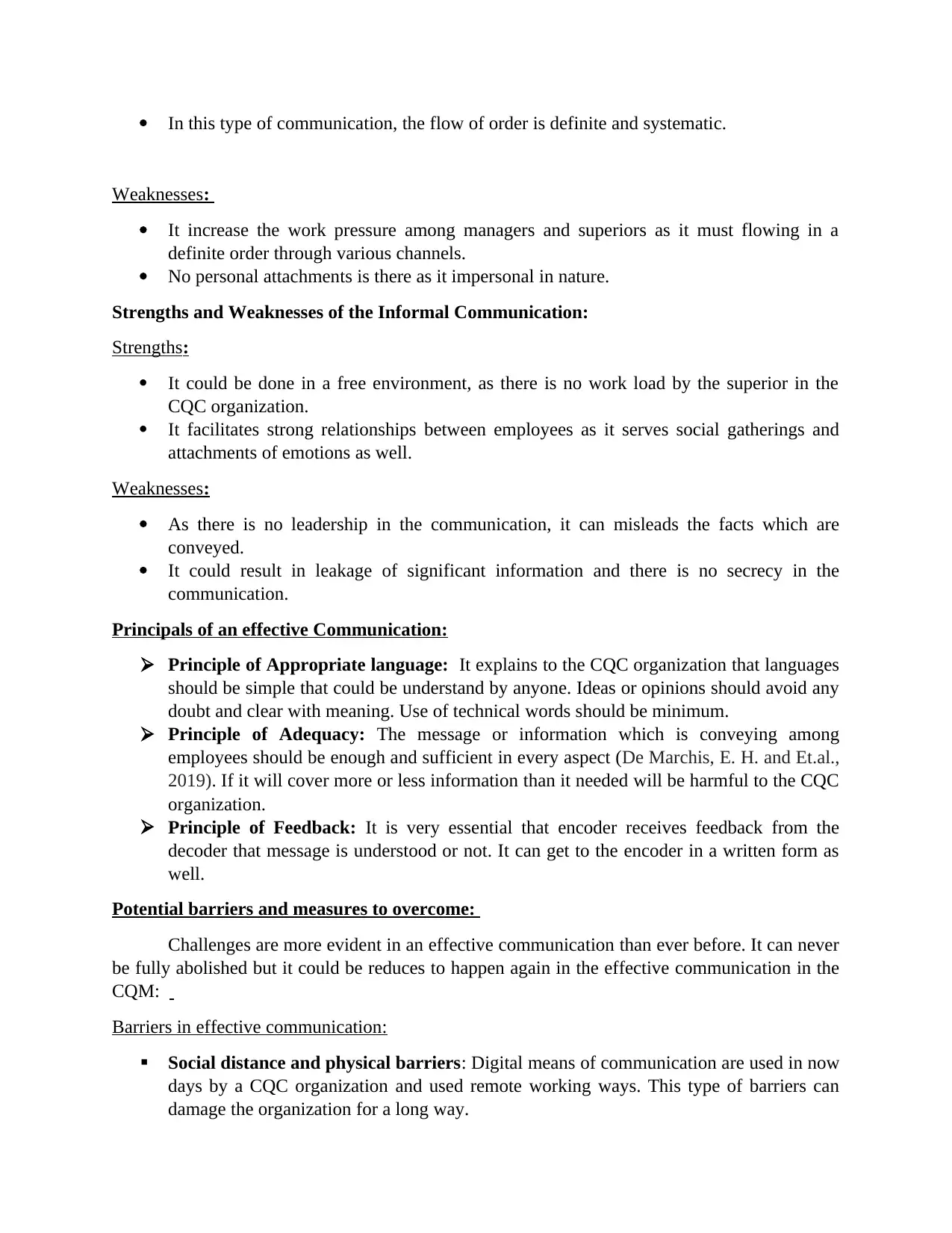
In this type of communication, the flow of order is definite and systematic.
Weaknesses:
It increase the work pressure among managers and superiors as it must flowing in a
definite order through various channels.
No personal attachments is there as it impersonal in nature.
Strengths and Weaknesses of the Informal Communication:
Strengths:
It could be done in a free environment, as there is no work load by the superior in the
CQC organization.
It facilitates strong relationships between employees as it serves social gatherings and
attachments of emotions as well.
Weaknesses:
As there is no leadership in the communication, it can misleads the facts which are
conveyed.
It could result in leakage of significant information and there is no secrecy in the
communication.
Principals of an effective Communication:
Principle of Appropriate language: It explains to the CQC organization that languages
should be simple that could be understand by anyone. Ideas or opinions should avoid any
doubt and clear with meaning. Use of technical words should be minimum.
Principle of Adequacy: The message or information which is conveying among
employees should be enough and sufficient in every aspect (De Marchis, E. H. and Et.al.,
2019). If it will cover more or less information than it needed will be harmful to the CQC
organization.
Principle of Feedback: It is very essential that encoder receives feedback from the
decoder that message is understood or not. It can get to the encoder in a written form as
well.
Potential barriers and measures to overcome:
Challenges are more evident in an effective communication than ever before. It can never
be fully abolished but it could be reduces to happen again in the effective communication in the
CQM:
Barriers in effective communication:
Social distance and physical barriers: Digital means of communication are used in now
days by a CQC organization and used remote working ways. This type of barriers can
damage the organization for a long way.
Weaknesses:
It increase the work pressure among managers and superiors as it must flowing in a
definite order through various channels.
No personal attachments is there as it impersonal in nature.
Strengths and Weaknesses of the Informal Communication:
Strengths:
It could be done in a free environment, as there is no work load by the superior in the
CQC organization.
It facilitates strong relationships between employees as it serves social gatherings and
attachments of emotions as well.
Weaknesses:
As there is no leadership in the communication, it can misleads the facts which are
conveyed.
It could result in leakage of significant information and there is no secrecy in the
communication.
Principals of an effective Communication:
Principle of Appropriate language: It explains to the CQC organization that languages
should be simple that could be understand by anyone. Ideas or opinions should avoid any
doubt and clear with meaning. Use of technical words should be minimum.
Principle of Adequacy: The message or information which is conveying among
employees should be enough and sufficient in every aspect (De Marchis, E. H. and Et.al.,
2019). If it will cover more or less information than it needed will be harmful to the CQC
organization.
Principle of Feedback: It is very essential that encoder receives feedback from the
decoder that message is understood or not. It can get to the encoder in a written form as
well.
Potential barriers and measures to overcome:
Challenges are more evident in an effective communication than ever before. It can never
be fully abolished but it could be reduces to happen again in the effective communication in the
CQM:
Barriers in effective communication:
Social distance and physical barriers: Digital means of communication are used in now
days by a CQC organization and used remote working ways. This type of barriers can
damage the organization for a long way.
Paraphrase This Document
Need a fresh take? Get an instant paraphrase of this document with our AI Paraphraser

Disengagement: This is very important for both encoder and decoder to engage in a
communication, otherwise it will ruin the aim of the communication.
Listening: It is much more important than speaking. Many of the organizations such as
CQC organization do not give that much significance to the employee’s share of their
thoughts and worth to their feedback.
Measures to overcome the barriers:
Make Communication more agile: Encouraging upward communication in the CQC
organization and subordinates should be able to influence their target audience quickly
(Housman, L. T., 2017). It should be flow in both the ways so that their communication will be
more agile.
Switch to mobile first communication: Communication is highly digital now a days and
the CQC organization requires to understand their employee’s ideal devices to communicate
whether it is formal or informal.
TASK2
Communicate information in a variety of formats.
Oral and Written Communication in CQC organization:
Oral Communication could be used in anywhere in informal communication; during
meetings of staff and in formal communication such as speeches and more. It is more effective
and easy to communicate things, it is more powerful tool to communicate as it not includes
words but also pitch, tone, volume and speed (Acker, G. M., 2018). Immediate response in oral
communication for CQC organization can help in providing or getting clarifications and
explanations.
Examples of oral communication in informal communication such as telephonic conversations,
face to face conversation; while in informal communication includes business meeting
presentation, lectures, speeches and more.
While in written communication, it is produce by letters, notices, reports, contracts, time-
table, instruction manuals and many more. It is useful when CQC organization want to convey
information to number of employees at a time. It is advantageous for the organization to use it as
a record and reference but it should be clearly and accurately drafted.
Examples of written communication: internet websites, email, contracts, letters and many more.
Produce an oral presentation:
Preparing a good oral presentation is an art gains attention of the audience by careful
conscious planning and attention to convey it to the audience. It might also add special notes,
computer presentation software and visual ads. Some key points that must be considering to
produce oral presentation:
Start with an attractive outline and create good switches between sections.
communication, otherwise it will ruin the aim of the communication.
Listening: It is much more important than speaking. Many of the organizations such as
CQC organization do not give that much significance to the employee’s share of their
thoughts and worth to their feedback.
Measures to overcome the barriers:
Make Communication more agile: Encouraging upward communication in the CQC
organization and subordinates should be able to influence their target audience quickly
(Housman, L. T., 2017). It should be flow in both the ways so that their communication will be
more agile.
Switch to mobile first communication: Communication is highly digital now a days and
the CQC organization requires to understand their employee’s ideal devices to communicate
whether it is formal or informal.
TASK2
Communicate information in a variety of formats.
Oral and Written Communication in CQC organization:
Oral Communication could be used in anywhere in informal communication; during
meetings of staff and in formal communication such as speeches and more. It is more effective
and easy to communicate things, it is more powerful tool to communicate as it not includes
words but also pitch, tone, volume and speed (Acker, G. M., 2018). Immediate response in oral
communication for CQC organization can help in providing or getting clarifications and
explanations.
Examples of oral communication in informal communication such as telephonic conversations,
face to face conversation; while in informal communication includes business meeting
presentation, lectures, speeches and more.
While in written communication, it is produce by letters, notices, reports, contracts, time-
table, instruction manuals and many more. It is useful when CQC organization want to convey
information to number of employees at a time. It is advantageous for the organization to use it as
a record and reference but it should be clearly and accurately drafted.
Examples of written communication: internet websites, email, contracts, letters and many more.
Produce an oral presentation:
Preparing a good oral presentation is an art gains attention of the audience by careful
conscious planning and attention to convey it to the audience. It might also add special notes,
computer presentation software and visual ads. Some key points that must be considering to
produce oral presentation:
Start with an attractive outline and create good switches between sections.
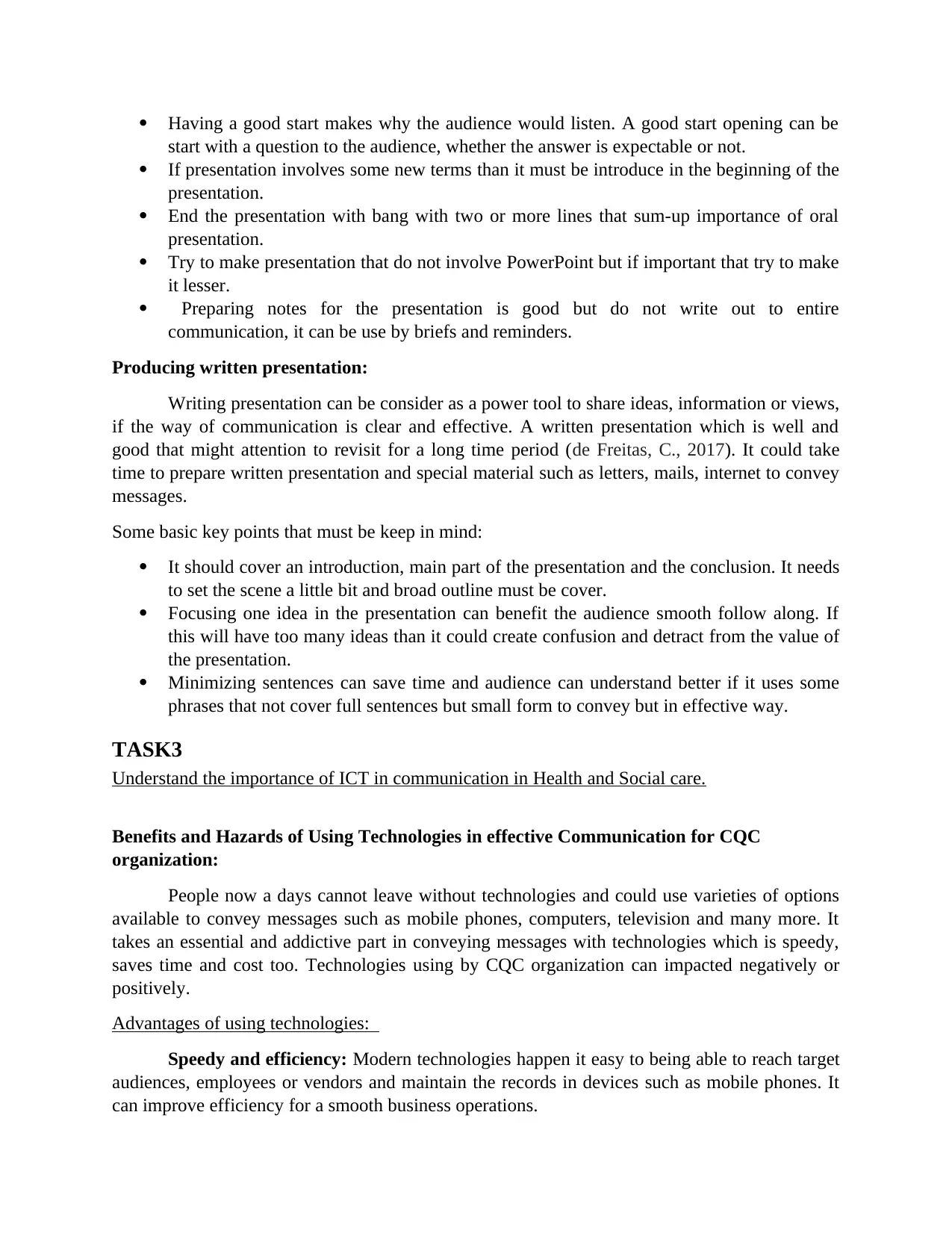
Having a good start makes why the audience would listen. A good start opening can be
start with a question to the audience, whether the answer is expectable or not.
If presentation involves some new terms than it must be introduce in the beginning of the
presentation.
End the presentation with bang with two or more lines that sum-up importance of oral
presentation.
Try to make presentation that do not involve PowerPoint but if important that try to make
it lesser.
Preparing notes for the presentation is good but do not write out to entire
communication, it can be use by briefs and reminders.
Producing written presentation:
Writing presentation can be consider as a power tool to share ideas, information or views,
if the way of communication is clear and effective. A written presentation which is well and
good that might attention to revisit for a long time period (de Freitas, C., 2017). It could take
time to prepare written presentation and special material such as letters, mails, internet to convey
messages.
Some basic key points that must be keep in mind:
It should cover an introduction, main part of the presentation and the conclusion. It needs
to set the scene a little bit and broad outline must be cover.
Focusing one idea in the presentation can benefit the audience smooth follow along. If
this will have too many ideas than it could create confusion and detract from the value of
the presentation.
Minimizing sentences can save time and audience can understand better if it uses some
phrases that not cover full sentences but small form to convey but in effective way.
TASK3
Understand the importance of ICT in communication in Health and Social care.
Benefits and Hazards of Using Technologies in effective Communication for CQC
organization:
People now a days cannot leave without technologies and could use varieties of options
available to convey messages such as mobile phones, computers, television and many more. It
takes an essential and addictive part in conveying messages with technologies which is speedy,
saves time and cost too. Technologies using by CQC organization can impacted negatively or
positively.
Advantages of using technologies:
Speedy and efficiency: Modern technologies happen it easy to being able to reach target
audiences, employees or vendors and maintain the records in devices such as mobile phones. It
can improve efficiency for a smooth business operations.
start with a question to the audience, whether the answer is expectable or not.
If presentation involves some new terms than it must be introduce in the beginning of the
presentation.
End the presentation with bang with two or more lines that sum-up importance of oral
presentation.
Try to make presentation that do not involve PowerPoint but if important that try to make
it lesser.
Preparing notes for the presentation is good but do not write out to entire
communication, it can be use by briefs and reminders.
Producing written presentation:
Writing presentation can be consider as a power tool to share ideas, information or views,
if the way of communication is clear and effective. A written presentation which is well and
good that might attention to revisit for a long time period (de Freitas, C., 2017). It could take
time to prepare written presentation and special material such as letters, mails, internet to convey
messages.
Some basic key points that must be keep in mind:
It should cover an introduction, main part of the presentation and the conclusion. It needs
to set the scene a little bit and broad outline must be cover.
Focusing one idea in the presentation can benefit the audience smooth follow along. If
this will have too many ideas than it could create confusion and detract from the value of
the presentation.
Minimizing sentences can save time and audience can understand better if it uses some
phrases that not cover full sentences but small form to convey but in effective way.
TASK3
Understand the importance of ICT in communication in Health and Social care.
Benefits and Hazards of Using Technologies in effective Communication for CQC
organization:
People now a days cannot leave without technologies and could use varieties of options
available to convey messages such as mobile phones, computers, television and many more. It
takes an essential and addictive part in conveying messages with technologies which is speedy,
saves time and cost too. Technologies using by CQC organization can impacted negatively or
positively.
Advantages of using technologies:
Speedy and efficiency: Modern technologies happen it easy to being able to reach target
audiences, employees or vendors and maintain the records in devices such as mobile phones. It
can improve efficiency for a smooth business operations.
⊘ This is a preview!⊘
Do you want full access?
Subscribe today to unlock all pages.

Trusted by 1+ million students worldwide
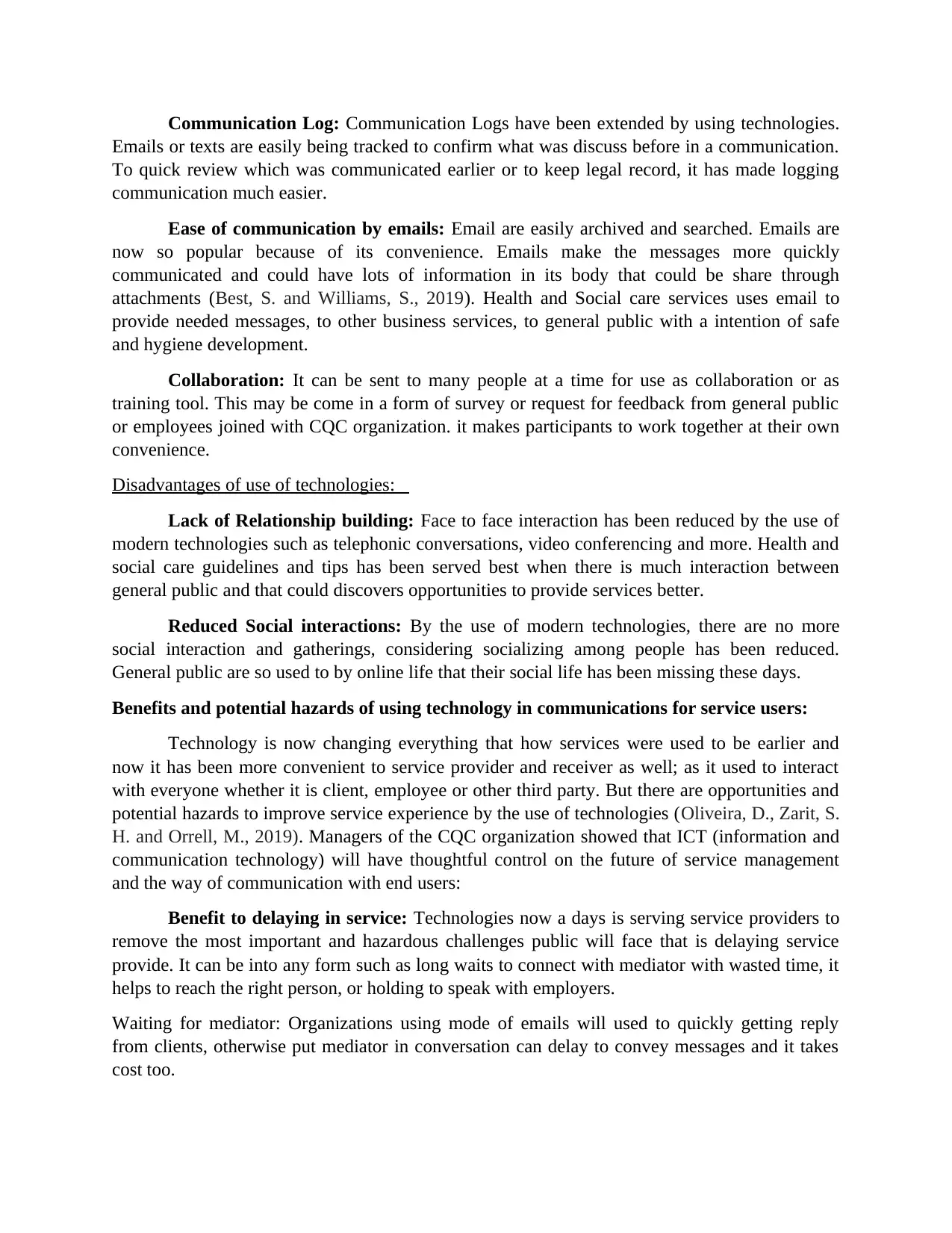
Communication Log: Communication Logs have been extended by using technologies.
Emails or texts are easily being tracked to confirm what was discuss before in a communication.
To quick review which was communicated earlier or to keep legal record, it has made logging
communication much easier.
Ease of communication by emails: Email are easily archived and searched. Emails are
now so popular because of its convenience. Emails make the messages more quickly
communicated and could have lots of information in its body that could be share through
attachments (Best, S. and Williams, S., 2019). Health and Social care services uses email to
provide needed messages, to other business services, to general public with a intention of safe
and hygiene development.
Collaboration: It can be sent to many people at a time for use as collaboration or as
training tool. This may be come in a form of survey or request for feedback from general public
or employees joined with CQC organization. it makes participants to work together at their own
convenience.
Disadvantages of use of technologies:
Lack of Relationship building: Face to face interaction has been reduced by the use of
modern technologies such as telephonic conversations, video conferencing and more. Health and
social care guidelines and tips has been served best when there is much interaction between
general public and that could discovers opportunities to provide services better.
Reduced Social interactions: By the use of modern technologies, there are no more
social interaction and gatherings, considering socializing among people has been reduced.
General public are so used to by online life that their social life has been missing these days.
Benefits and potential hazards of using technology in communications for service users:
Technology is now changing everything that how services were used to be earlier and
now it has been more convenient to service provider and receiver as well; as it used to interact
with everyone whether it is client, employee or other third party. But there are opportunities and
potential hazards to improve service experience by the use of technologies (Oliveira, D., Zarit, S.
H. and Orrell, M., 2019). Managers of the CQC organization showed that ICT (information and
communication technology) will have thoughtful control on the future of service management
and the way of communication with end users:
Benefit to delaying in service: Technologies now a days is serving service providers to
remove the most important and hazardous challenges public will face that is delaying service
provide. It can be into any form such as long waits to connect with mediator with wasted time, it
helps to reach the right person, or holding to speak with employers.
Waiting for mediator: Organizations using mode of emails will used to quickly getting reply
from clients, otherwise put mediator in conversation can delay to convey messages and it takes
cost too.
Emails or texts are easily being tracked to confirm what was discuss before in a communication.
To quick review which was communicated earlier or to keep legal record, it has made logging
communication much easier.
Ease of communication by emails: Email are easily archived and searched. Emails are
now so popular because of its convenience. Emails make the messages more quickly
communicated and could have lots of information in its body that could be share through
attachments (Best, S. and Williams, S., 2019). Health and Social care services uses email to
provide needed messages, to other business services, to general public with a intention of safe
and hygiene development.
Collaboration: It can be sent to many people at a time for use as collaboration or as
training tool. This may be come in a form of survey or request for feedback from general public
or employees joined with CQC organization. it makes participants to work together at their own
convenience.
Disadvantages of use of technologies:
Lack of Relationship building: Face to face interaction has been reduced by the use of
modern technologies such as telephonic conversations, video conferencing and more. Health and
social care guidelines and tips has been served best when there is much interaction between
general public and that could discovers opportunities to provide services better.
Reduced Social interactions: By the use of modern technologies, there are no more
social interaction and gatherings, considering socializing among people has been reduced.
General public are so used to by online life that their social life has been missing these days.
Benefits and potential hazards of using technology in communications for service users:
Technology is now changing everything that how services were used to be earlier and
now it has been more convenient to service provider and receiver as well; as it used to interact
with everyone whether it is client, employee or other third party. But there are opportunities and
potential hazards to improve service experience by the use of technologies (Oliveira, D., Zarit, S.
H. and Orrell, M., 2019). Managers of the CQC organization showed that ICT (information and
communication technology) will have thoughtful control on the future of service management
and the way of communication with end users:
Benefit to delaying in service: Technologies now a days is serving service providers to
remove the most important and hazardous challenges public will face that is delaying service
provide. It can be into any form such as long waits to connect with mediator with wasted time, it
helps to reach the right person, or holding to speak with employers.
Waiting for mediator: Organizations using mode of emails will used to quickly getting reply
from clients, otherwise put mediator in conversation can delay to convey messages and it takes
cost too.
Paraphrase This Document
Need a fresh take? Get an instant paraphrase of this document with our AI Paraphraser

Reaching the right person: Sometimes it is not worthy to put mediator between conversations
with client, what if client wants to directly connect with the service provider or wants to make
their doubts clear fast. Technologies such as telephonic conversation will be benefited to this.
Hazards of using technologies: Trust, respect and honesty are basis of long term
relationship with service providers are not replaceable with the success of business (Samuelson,
M. B. and Et.al., 2017). But if the service is technology based merely then it will be hazardous to
the relationship as it creates distance of contacting clients directly.
Issues around Data protection and how it is implemented in Health and Social care:
Good data protection and ethics must be practiced by a CQC organization in a view not
only obey but also expectations of general public that must be a topic of protection. Data
protection are being established in 2020 around the world. The important issues that must be
consider by the respective organization such as:
Transparency and accountability: Data protection principles needs that when any
confidential data has been processed must be transparent and are responsible for the information
whose data are collecting and analyzing (Rubinstein, A. and Et.al., 2018). It must ne understand
the sensitivity and secrecy of data.
Annual security awareness programs do not cut it: It is a serious activity to protect
data and that is time to show that CQC organization is taking proper protection of data.
Protecting data is a series of reaction not a strategy: Overall goal of CQC organization
is to make sure about awareness and executive support of protecting confidential data not only
just producing it.
CONCLUSION
As per the above report, it has been concluded that proper communication is very
essential in any organization whether formal or informal; it requires skills to convey and offer
considering with good people. It is important to share and express opinions and feelings to
people around in the working enterprise or in personal life. It is well developed when it avoids
distraction, disturbance and having focused behavior between the two or more parties.
with client, what if client wants to directly connect with the service provider or wants to make
their doubts clear fast. Technologies such as telephonic conversation will be benefited to this.
Hazards of using technologies: Trust, respect and honesty are basis of long term
relationship with service providers are not replaceable with the success of business (Samuelson,
M. B. and Et.al., 2017). But if the service is technology based merely then it will be hazardous to
the relationship as it creates distance of contacting clients directly.
Issues around Data protection and how it is implemented in Health and Social care:
Good data protection and ethics must be practiced by a CQC organization in a view not
only obey but also expectations of general public that must be a topic of protection. Data
protection are being established in 2020 around the world. The important issues that must be
consider by the respective organization such as:
Transparency and accountability: Data protection principles needs that when any
confidential data has been processed must be transparent and are responsible for the information
whose data are collecting and analyzing (Rubinstein, A. and Et.al., 2018). It must ne understand
the sensitivity and secrecy of data.
Annual security awareness programs do not cut it: It is a serious activity to protect
data and that is time to show that CQC organization is taking proper protection of data.
Protecting data is a series of reaction not a strategy: Overall goal of CQC organization
is to make sure about awareness and executive support of protecting confidential data not only
just producing it.
CONCLUSION
As per the above report, it has been concluded that proper communication is very
essential in any organization whether formal or informal; it requires skills to convey and offer
considering with good people. It is important to share and express opinions and feelings to
people around in the working enterprise or in personal life. It is well developed when it avoids
distraction, disturbance and having focused behavior between the two or more parties.
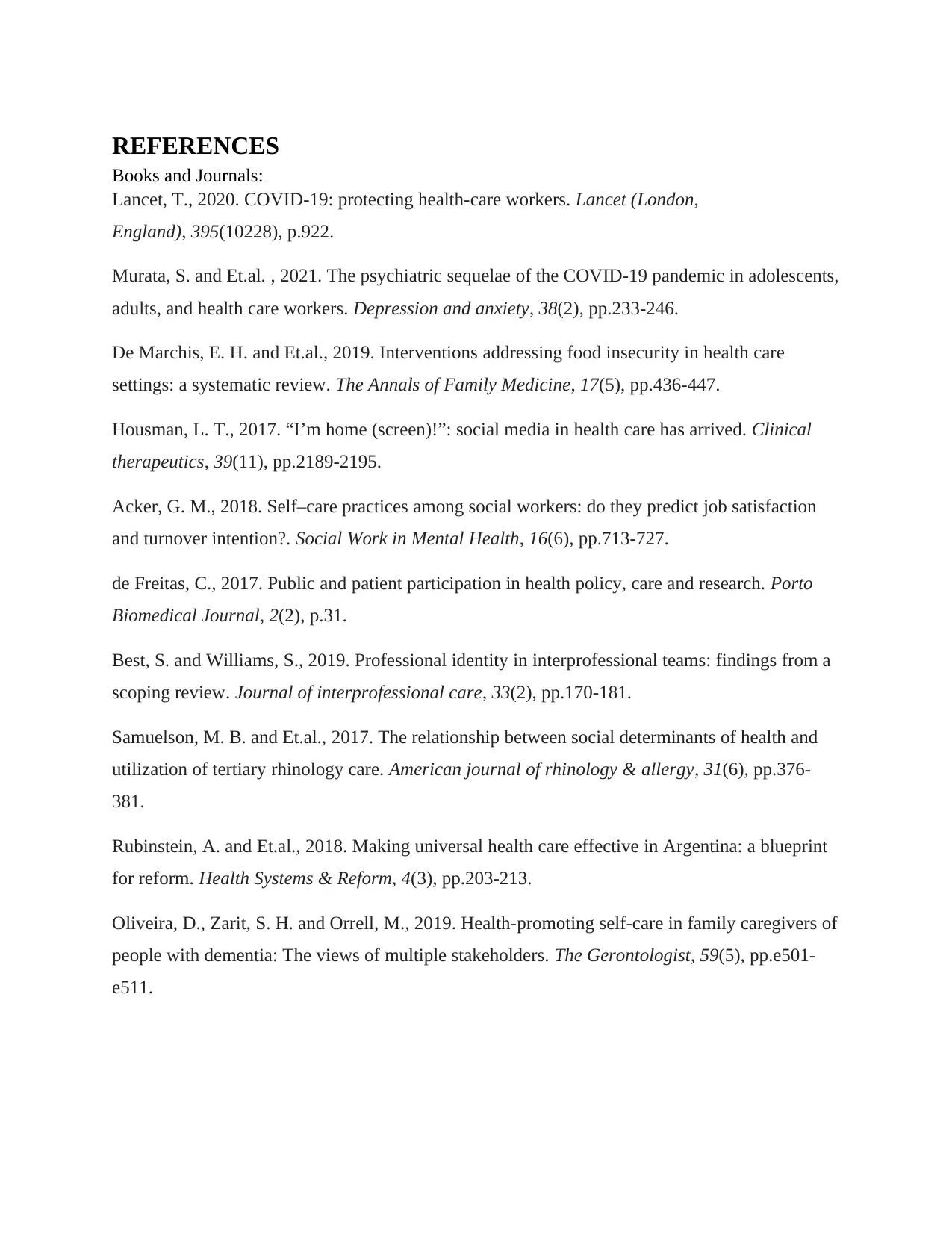
REFERENCES
Books and Journals:
Lancet, T., 2020. COVID-19: protecting health-care workers. Lancet (London,
England), 395(10228), p.922.
Murata, S. and Et.al. , 2021. The psychiatric sequelae of the COVID‐19 pandemic in adolescents,
adults, and health care workers. Depression and anxiety, 38(2), pp.233-246.
De Marchis, E. H. and Et.al., 2019. Interventions addressing food insecurity in health care
settings: a systematic review. The Annals of Family Medicine, 17(5), pp.436-447.
Housman, L. T., 2017. “I’m home (screen)!”: social media in health care has arrived. Clinical
therapeutics, 39(11), pp.2189-2195.
Acker, G. M., 2018. Self–care practices among social workers: do they predict job satisfaction
and turnover intention?. Social Work in Mental Health, 16(6), pp.713-727.
de Freitas, C., 2017. Public and patient participation in health policy, care and research. Porto
Biomedical Journal, 2(2), p.31.
Best, S. and Williams, S., 2019. Professional identity in interprofessional teams: findings from a
scoping review. Journal of interprofessional care, 33(2), pp.170-181.
Samuelson, M. B. and Et.al., 2017. The relationship between social determinants of health and
utilization of tertiary rhinology care. American journal of rhinology & allergy, 31(6), pp.376-
381.
Rubinstein, A. and Et.al., 2018. Making universal health care effective in Argentina: a blueprint
for reform. Health Systems & Reform, 4(3), pp.203-213.
Oliveira, D., Zarit, S. H. and Orrell, M., 2019. Health-promoting self-care in family caregivers of
people with dementia: The views of multiple stakeholders. The Gerontologist, 59(5), pp.e501-
e511.
Books and Journals:
Lancet, T., 2020. COVID-19: protecting health-care workers. Lancet (London,
England), 395(10228), p.922.
Murata, S. and Et.al. , 2021. The psychiatric sequelae of the COVID‐19 pandemic in adolescents,
adults, and health care workers. Depression and anxiety, 38(2), pp.233-246.
De Marchis, E. H. and Et.al., 2019. Interventions addressing food insecurity in health care
settings: a systematic review. The Annals of Family Medicine, 17(5), pp.436-447.
Housman, L. T., 2017. “I’m home (screen)!”: social media in health care has arrived. Clinical
therapeutics, 39(11), pp.2189-2195.
Acker, G. M., 2018. Self–care practices among social workers: do they predict job satisfaction
and turnover intention?. Social Work in Mental Health, 16(6), pp.713-727.
de Freitas, C., 2017. Public and patient participation in health policy, care and research. Porto
Biomedical Journal, 2(2), p.31.
Best, S. and Williams, S., 2019. Professional identity in interprofessional teams: findings from a
scoping review. Journal of interprofessional care, 33(2), pp.170-181.
Samuelson, M. B. and Et.al., 2017. The relationship between social determinants of health and
utilization of tertiary rhinology care. American journal of rhinology & allergy, 31(6), pp.376-
381.
Rubinstein, A. and Et.al., 2018. Making universal health care effective in Argentina: a blueprint
for reform. Health Systems & Reform, 4(3), pp.203-213.
Oliveira, D., Zarit, S. H. and Orrell, M., 2019. Health-promoting self-care in family caregivers of
people with dementia: The views of multiple stakeholders. The Gerontologist, 59(5), pp.e501-
e511.
⊘ This is a preview!⊘
Do you want full access?
Subscribe today to unlock all pages.

Trusted by 1+ million students worldwide
1 out of 9
Related Documents
Your All-in-One AI-Powered Toolkit for Academic Success.
+13062052269
info@desklib.com
Available 24*7 on WhatsApp / Email
![[object Object]](/_next/static/media/star-bottom.7253800d.svg)
Unlock your academic potential
Copyright © 2020–2025 A2Z Services. All Rights Reserved. Developed and managed by ZUCOL.



